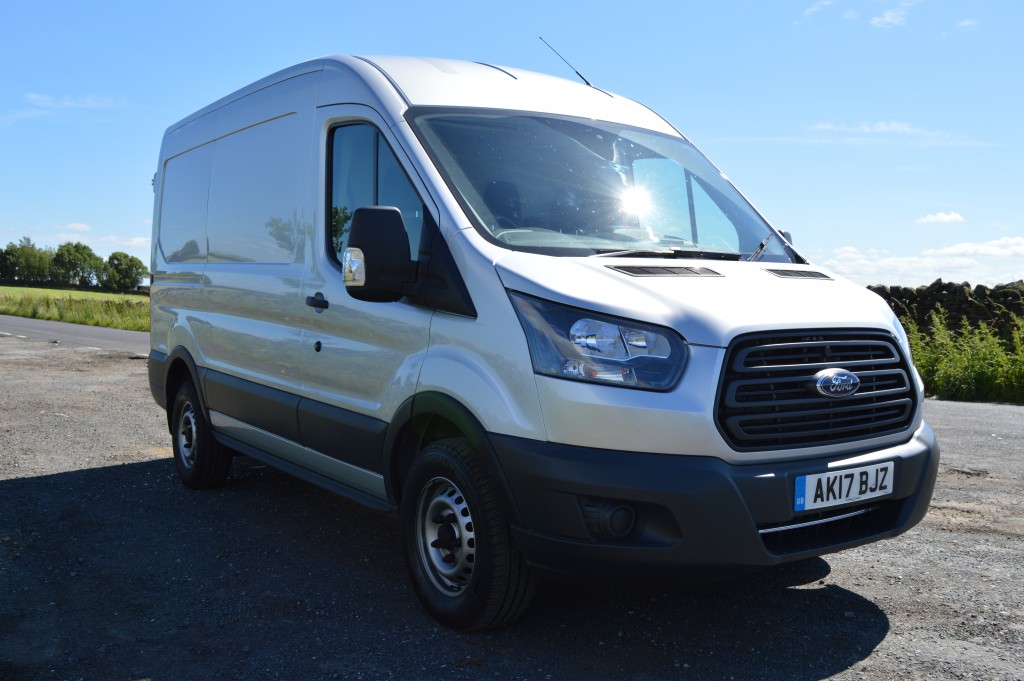Road Test and Review – Ford Transit L2H2 130PS ‘SelectShift’ Automatic
A smooth operator…
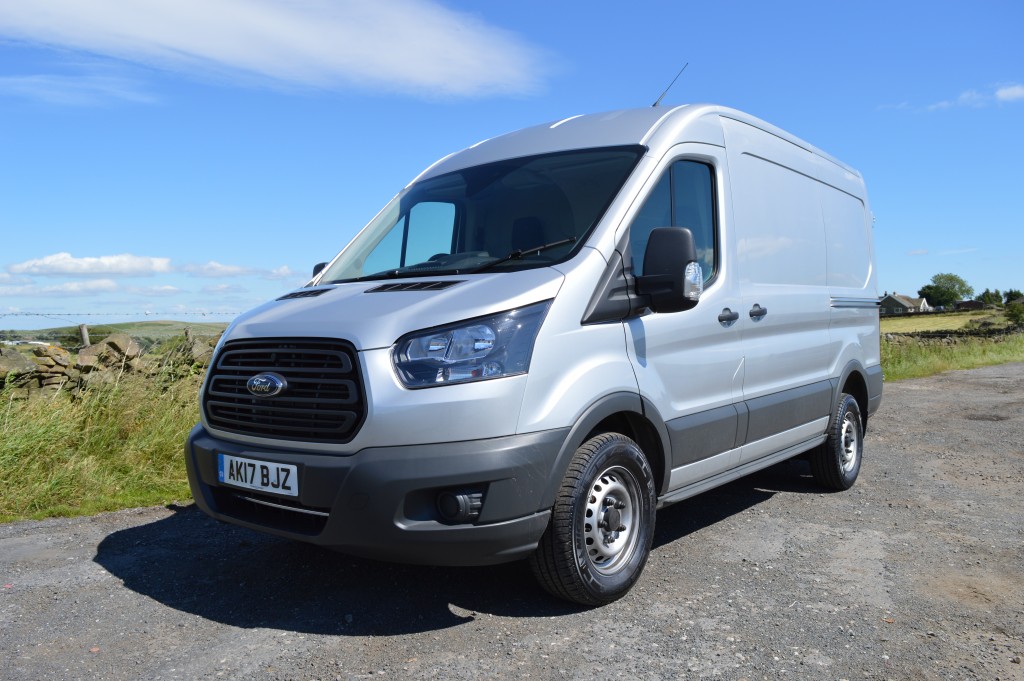
Background
The relatively new ‘big’ Ford Transit (as opposed to its smaller sibling, the Transit Custom), codenamed V363, is a familiar sight on our roads having been launched back in late 2013. A firm favourite with fleets and small businesses alike, it has continued to keep its main competitors, the Mercedes-Benz Sprinter and the (recently revamped) Volkswagen Crafter at bay. The name ‘Transit’ is used, often erroneously by Joe Public to describe any large van and this undoubtedly causes angst amongst Ford’s competitors who can only dream of having such brand recognition.
It’s often said though that these days there are no bad vans out there, and no manufacturer can afford to arrogantly sit on their laurels believing that they cannot be caught. In the last 12 months the Transit has gained a completely new engine and, belatedly in comparison to some of the competition is just becoming available with a new ‘SelectShift’ 6 speed automatic gearbox. Automatic transmissions are in increasing demand from fleets involved in operations such as supermarket home delivery and undoubtedly the manufacturer has missed out on opportunities being a latecomer to the sector. Ford very kindly (and perhaps bravely!) offered a pre-production van fitted with the new gearbox for test – indeed this van was the very one displayed on the Ford stand at the Commercial Vehicle show this year.
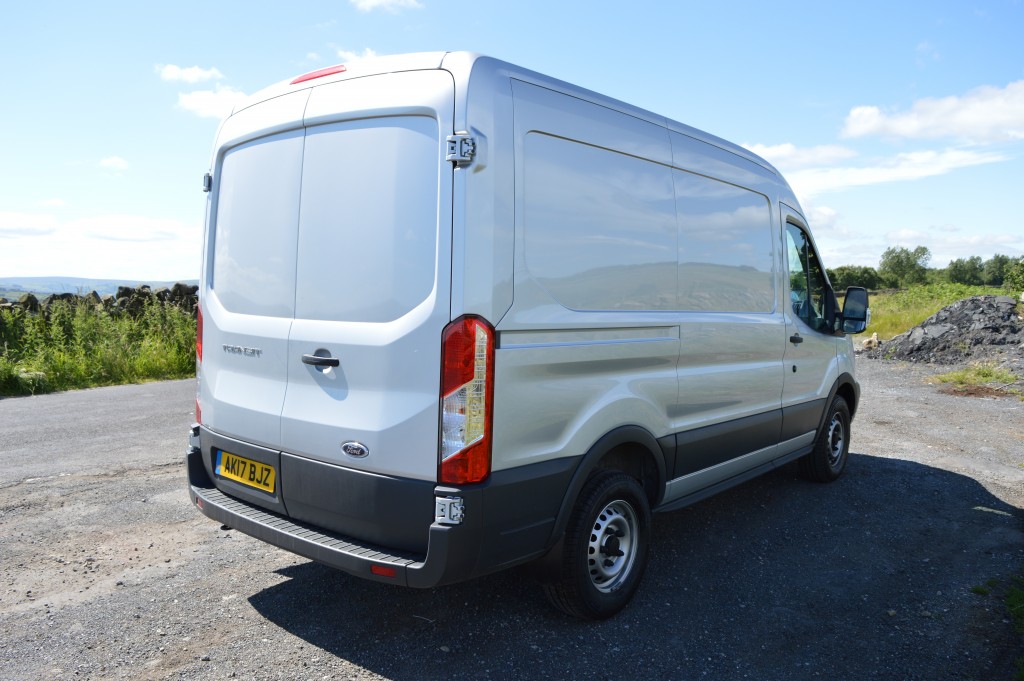
Specification and features
Available in three body lengths, two heights and multiple GVW options, the Transit is now fitted with a 2 litre ‘EcoBlue’ Euro 6 engine shared with the Transit Custom. With outputs of 105, 130 and 170PS the new engines offer increased torque compared to the outgoing 2.2 litre units and a claimed reduction in fuel consumption of around 10%. Recognising that this size of van is often used more as a workhorse compared to its smaller siblings, Ford only offer the van in Base and Trend trim levels and not the more luxurious Limited guise found elsewhere in the CV range. Whilst the Base van isn’t exactly loaded with niceties, Ford have not skimped on safety features. All vans come as standard with an upgraded Electronic Stability Control (ESC) system, Side Wind Stabilisation, Curve Control (provides a safe and controlled braking action if entering a bend too quickly) and Roll Stability Control, a sophisticated system utilising a combination of engine torque and individual wheel braking to reduce the risk of the van rolling. Base also includes Bluetooth and electric front windows. The Trend derivative adds front fog lights, electric, heated door mirrors, front and rear parking sensors and a heated windscreen. The interior gains a Ford SYNC media unit, cruise control and a multipurpose dual passenger seat. Vans are available in front, rear or all wheel drive although the SelectShift box can only be specified in conjunction with FWD. Payloads for the 3.5t GVW standard panel vans vary between 1111 and 1446 kg.
The test van supplied was a L2H2 (the shortest and lowest) FWD Base model fitted with the 130PS engine. Being a show van it had a number of items of optional equipment, including air conditioning, low visibility pack, SYNC unit, a load floor and LED loadspace lighting.
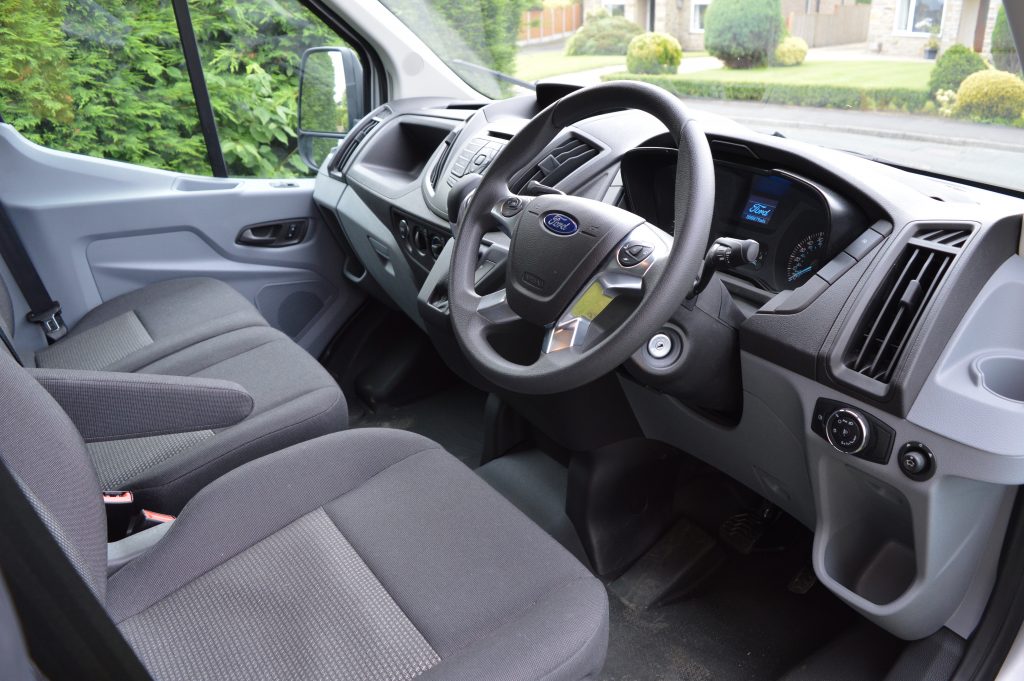
The cab environment
I often start these reviews by commenting how easy (or otherwise) it is for the driver to access the vehicle. This is a vital factor for a van, as a vehicle being used on a multi-drop parcel delivery operation will see the driver enter and exit the van dozens of times a day. The Transit excels in this regard and the driver will find himself seated with little fuss and without undue effort or contortion.
Compared to some of the competition, the cab environment feels somewhat smaller. Other large vans can almost have a feel of a small truck interior with too much space. The Transit gives an impression of being comfortably compact, but spacious enough for the passengers and driver not to get unduly in the way of each other. This environment is complemented by the dash – unmistakably Ford to anyone who has driven any vehicle produced in recent years it is modern, functional, and, most importantly unimposing. Competitors offerings often have the appearance of a cliff face and can obscure the lower section of the windscreen but, this certainly isn’t the case in the Transit, an excellent balance having been achieved. The only slight downside is that the buttons for the radio etc. are quite a stretch for the driver, but, the multifunction steering wheel controls cover the majority of day to day operations. In cab storage, whilst not perhaps class leading is certainly adequate with facilities on the dash front and top, together with receptacles at either end which can accommodate the benchmark 2 litre drink bottle. Door bins offer further space and there is also some limited capacity on a shelf above the windscreen.
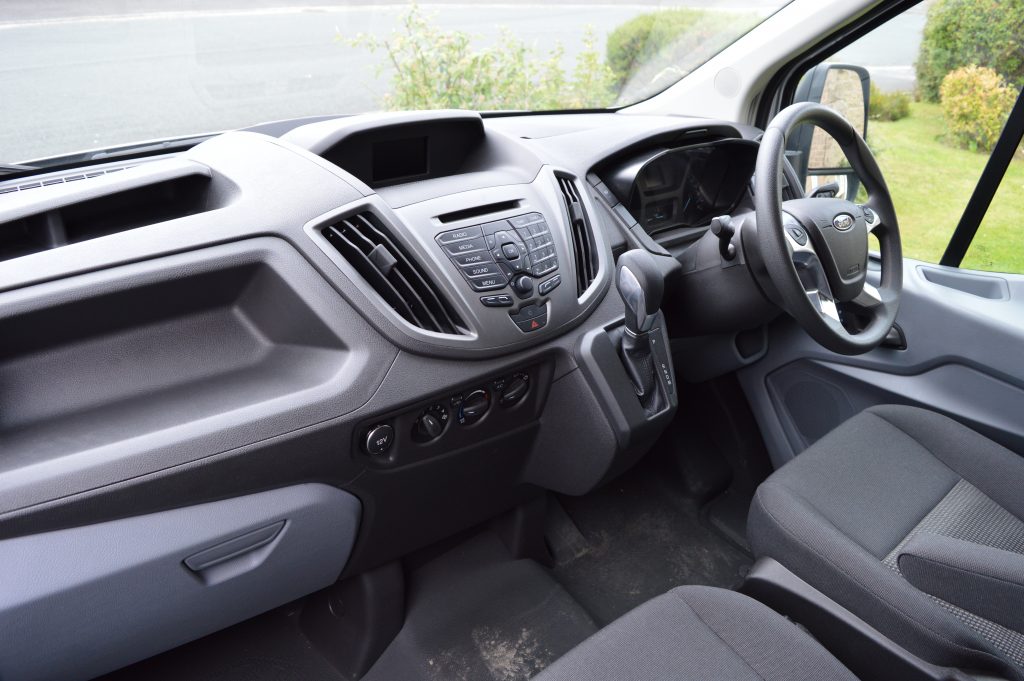
Loadspace
Access to the rear of the van is through two 180 degree hinged doors and by a full width rear step which doubles up as the bumper. Although the H2 is the lowest roof height available working height is perfectly adequate for all but the tallest. The standard steel bulkhead offers good protection to the cab occupants and the LED lighting (optional) fitted to the test van makes a huge difference to those operating in poor light. Wheelarch intrusion compares very well to the competition and the good sized side loading door offers the flexibility which operators have become accustomed to.
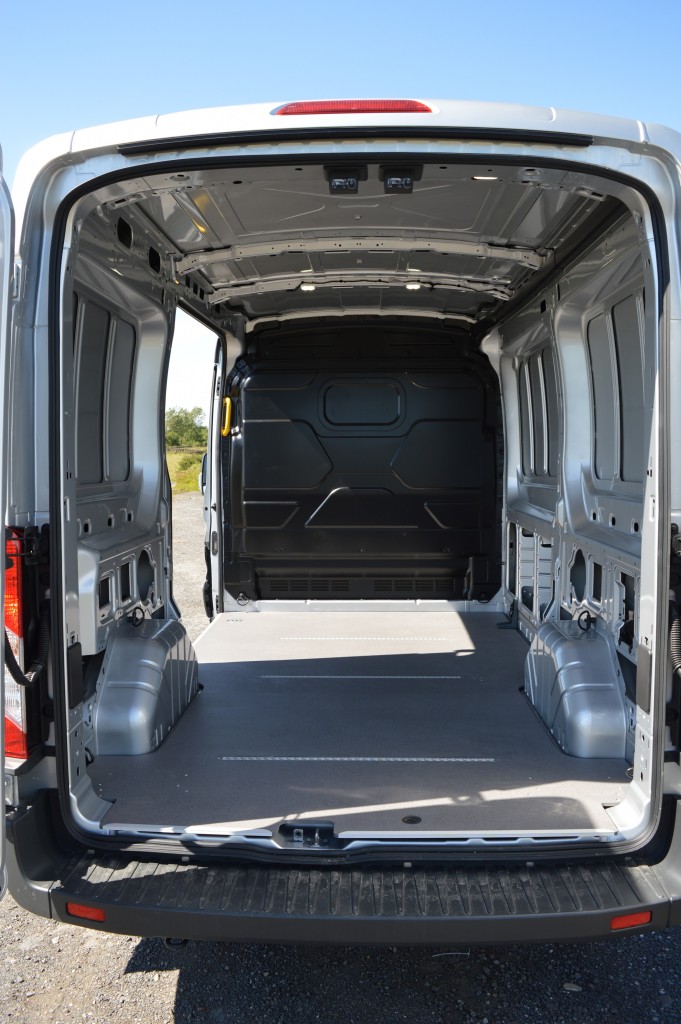
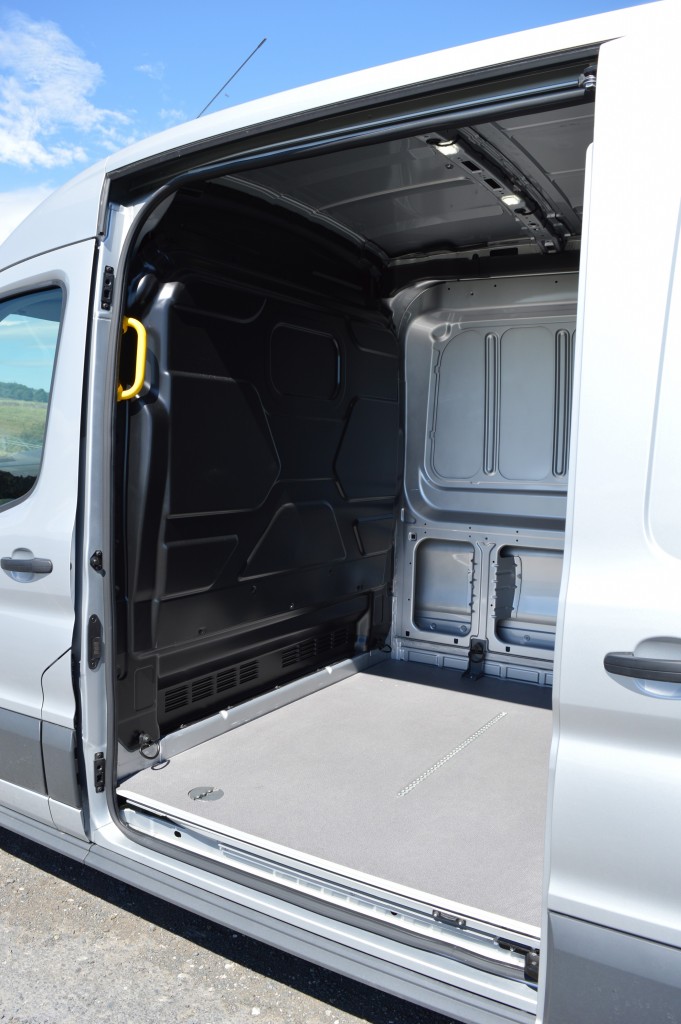
On the road
The new ‘EcoBlue’ engine gives a great impression from the start, firing up without fuss and with little noise on tickover. Dropping the dash mounted selector into ‘D’, the van moves off effortlessly. Ford have made quite some noise about how technically advanced the transmission is and how intelligently changes are made on the move. These claims are vindicated in practice, smooth up and down changes being made precisely when the driver would have chosen, whether the van is being driven briskly or in a more sedate manner. This is undoubtedly aided by the considerable torque generated by the 130ps engine, the gearbox control software clearly recognising this and acting accordingly. It has to be said however that when pushed, there is some noise intrusion at higher engine speeds but this diminishes as the transmission moves up its ratios.
On the side of the control lever is a small switch allowing for manual gear changes. Whilst this works well, it would have been much nicer if paddle controls could have been fitted under the steering wheel, therefore removing the need to take ones hand off the wheel. Obviously, it could be argued that you have to do this anyway on a van with a manual transmission but, nevertheless it would have been a nice (albeit possibly cost prohibitive) touch.
Steering and handling all perform to expectation, and at speed on the motorway noise levels remain remarkably low. Ford have worked wonders here, with almost no wind noise despite the large mirrors, and road and engine noise being almost unnoticeable.
During my week with the van, I covered around 350 miles of mixed, but unladen use. Although no accurate fuel consumption figures were taken, the trip computer recorded an overall average of 32.5 mpg which, if close to accurate was perhaps disappointing although it should be taken into account that the van had covered a total mileage of well under 1000 miles.
Conclusion
I have driven all van manufacturers current automatic transmission offerings. The benchmark will continue to be the Hi-Matic unit fitted to the latest generation of the Iveco Daily. Clearly displaying its passenger car heritage (including the likes of Maserati) the imperceptible nature of its ratio changes is astounding. Although the Transit doesn’t quite achieve this level of refinement, the intelligence built into the software makes the SelectShift unit a contender for being an overall class leader. The driver can have confidence at all times that the van will remain in an appropriate gear and will instantly change upon encountering different conditions. A great job done by the Ford engineers and undoubtedly the unit will be warmly received by fleet managers.
From any other perspective, the Transit deservedly remains a favourite and has only been made even better by the introduction of the torque laden EcoBlue power units. Combining this with build quality, dealer back up, a plethora of safety features as standard and an enviable reputation it’s difficult to envisage any manufacturer permanently toppling its crown as market leader in its sector. After all, to quote an industry cliché, ‘no one ever got fired for buying a Transit’…
Price as tested £29916 ex VAT OTR, without optional equipment but including SelectShift automatic gearbox.
